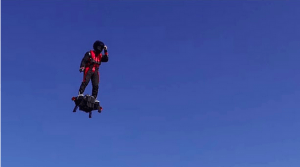Flyboard Air: Franky Zapata looks strangely calm for a man standing on nothing but a pile of jet thrust
By By Loz Blain,
In the video he soars as high as 30 meters (98 ft) above the ground, instantly leapfrogging the best personal flight efforts we’ve seen from manned multicopter operators – although like previous efforts, Zapata is wise to keep his flight testing over water where an engine failure will be less likely to turn him into a jam pancake.
Franky Zapata’s water-jet Flyboards have very quickly become a popular vacation experience, but the French jet ski champion has bigger goals in mind. Over the weekend, he released the first video that claims to show his new Flyboard Air in action. The Air ditches the water jet for what appears to be a jet turbine engine, and allows him to fly untethered through the sky to a maximum height of 10,000 feet and a maximum endurance of 10 minutes. It’s early days yet, but we humbly propose a jet race against David Mayman and his JB-9 Jetpack.
We’d estimate that no human alive has more experience operating a standing jet platform than Franky Zapata. The French jet ski champion stunned the world in 2011 with the release of his Flyboard, a jet platform tethered to a jet ski that put enough thrust under your feet to lift you 9 meters (29.5 ft) into the air on a jet of water and perform all sorts of aerobatics.
The simple, fun Flyboard very quickly became one of the must-do holiday experiences of the noughties. It was tricky to fly, required a lot of core body strength and sent a lot of people forcefully into the drink – but it was the closest thing you could get to a safe and affordable personal flight experience.
And as it turns out, it may have been a stepping stone to something far greater.
Over the weekend, Zapata released the first video of his latest invention: the Flyboard Air. Gone is the jet ski, gone is the hose, and gone is the tether. This thing appears to take the handling and control system of the Flyboard, but replace the water jets with at least one jet turbine engine and what appears to be a backpack fuel tank.
Details are being kept deliberately scant, but Zapata has released the following figures: The Flyboard Air can go as high as 10,000 feet (3,048 m), with 10 minutes of flight possible and a top ground speed around 150 km/h (93 mph).
That puts Zapata in a similar league with David Mayman and Nelson Tyler, whose JB-9 jetpack is also capable of such numbers. And it saddles him with similar problems: what do you do in case of engine failure? How can you make it safer for non-Zapata level athletes to fly? Can you responsibly sell these things to people?
Parachutes are more or less useless below 100 feet, as they just don’t have time to open and slow you down. Even that’s a stretch – 250 feet is about as low as you want to get to feel like you’re not pushing your luck. And yet, presumably, people will want to fly these things low enough to get a bird’s eye perspective on the world. That means both the Flyboard Air and the JB-9 will spend a lot of their flight time in a deadly zone between 30 and 200 feet off the ground where the failure of a jet engine or a miscalculation in fuel load will be catastrophic. With no wings or autorotation to bring them down softly, they’re entirely reliant on the thrust they produce.
Still, safety issues aside, the Flyboard Air is a proper space-age flying platform, and Franky Zapata is the perfect man to pilot it. He makes it look nimble and fun, if slightly terrifying. It’ll be fascinating to see where things go from here, but clearly we need to get Zapata and Mayman together for some kind of jetpack race.

